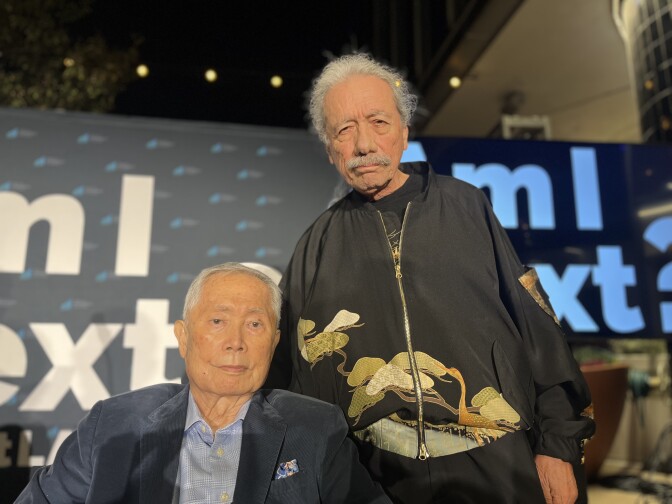Truth matters. Community matters. Your support makes both possible. LAist is one of the few places where news remains independent and free from political and corporate influence. Stand up for truth and for LAist. Make your year-end tax-deductible gift now.
Public art protest of ICE raids asks 'Am I Next?' Campaign features prominent Trump critics

Drive through downtown Los Angeles at night and you’ll see billboard-sized portraits of Angelenos projected onto landmarks like the Japanese American National Museum and LA Plaza de Cultura y Artes.
It’s not an ad campaign. It’s protest through art — a new project condemning the federal immigration raids that have swept up thousands across the region in recent months.
One by one, portraits of dozens of Angelenos who’ve voiced their opposition to the raids flash across the buildings. A few are recognizable right away like Edward James Olmos and George Takei, veteran actors and activists who’ve fought against racial injustice.
“This is totally, totally one of the most extraordinary moments of my life, because it's one of the most difficult,” Olmos said.
Olmos compared this period to the civil unrest that rocked L.A. in 1992. He famously led cleanup efforts afterward.
“I did a lot of work during that period of time in the community to help bring it back,” Olmos said. “But this is brutal because it's just beginning. People don't understand. They think, ‘Oh, well, you know, they came in here, they did their thing, and now they left.’ No, it's just beginning.”
Lending their voices
The Department of Homeland Security says it’s made more than 5,000 arrests in L.A. since June. And the sweeps continue.
“Unlike those who hide behind masks, we show our faces — proud, visible, and unafraid,” said Miguel Santana, president and CEO of the California Community Foundation, which is leading the campaign.
The foundation’s own building on Temple Street is a canvas for the glowing black and white portraits that drivers can see from the 101. “Am I next?” reads the message next to the faces.
“When anyone's rights are stripped away, everyone is at risk,” Santana said. “When guilt replaces innocence, our Constitution is under attack. That's why we ask, ‘Am I next?’ Because any of us could be.”

Interspersed between the photos are the first names of people seized by immigration agents with a line about the circumstances:
Mauricio, waiting for a bus.
Juan, on lunch break from his construction job.
Miriam, waiting in court
Echoes of WWII
For Japanese Americans who lived through World War II, the raids feels like a repeat of history. Use of force. Loss of due process. Targeting of ethnic communities.
George Takei recalls the day his family was forced from their home to be incarcerated with other Japanese Americans in camps. Two soldiers stomped up their porch, he said, and banged on the front door.
“They carried rifles with shiny bayonets on them,” Takei recalled. “My father came rushing out, and the soldier said, ‘Get your family out of this house.’”
When Takei’s father asked for more time to pack, one soldier pointed his bayonet at his face. The family raced to gather their belongings. Takei’s mother was the last to come out.

“She had our baby sister in one arm, a huge duffel bag in the other and tears were streaming down her cheeks,” Takei said. “The terror of that morning is seared into my memory.”
Takei is raising his voice now, when few did for his family back then. His portrait — and those of others — will continue to be projected onto the buildings until the raids end, Santana said.
A continuing project
The portraits are also being projected onto the sides of the Museum of Latin American Art in Long Beach and the Social and Public Art Resource Center in Venice.
In addition to the projected portraits, the LA Plaza de Cultura y Artes is also showing an installation about belonging in L.A. with more than 30 large-scale digital images by nine local artists including Lalo Alcaraz and Brandy Gonzalez.
"Their work tells stories of migration, struggle, resilience and unity," said LA Plaza's CEO Leticia Rhi Buckley. "These are not just visuals. They are voices."
Santana said his foundation is in conversations with more institutions around the state who want to show the "Am I Next" portraits. The campaign isn’t limited to large buildings, with Santana noting that the images can be projected onto people’s homes.
In the meantime, more portraits are being added to the project. Learn more at the Am I Next website.









